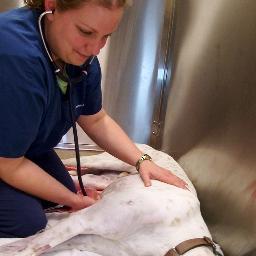The Client Connection by Megan Brashear, CVT, VTS (ECC)
This month, I’ll be featuring an article from my dear friend and colleague, Megan Brashear. Megan is the Education Manager at DoveLewis in Portland, OR and a contributor at On the Floor @Dove. I’m thrilled to be speaking with Megan for the first time at the Gulf Atlantic Veterinary Conference. We will be discussing hot industry trends from the perspective of a Veterinary Tech Consultant and Veterinary Information Tech Consultant.
The Client Connection

Ask a room full of veterinary professionals why they chose veterinary medicine over human medicine. You’ll get a smattering of answers “I want to help the animals”; “I fell in love with James Herriot as a child”; and then it comes out. “I don’t like people”.
While I know that recent grads are receiving all kinds of training in client communication and tech students seem to be more client savvy these days, there are still way too many veterinary folks who assume they can hide in the back with the patients and not have to deal with those crazy owners. I used to be one of them. Clinically introverted (my own term for what used to be almost crippling shyness and fear of talking to people I don’t know), it took a great dose of courage for me to call clients to remind them of their appointments the next day. The people were a hurdle to get around before I got to do what I wanted to do, which was treat the animal. When I started at DoveLewis (sooo many years ago…) one of the selling points for technicians was that we didn’t have to have client contact! Yikes. The profession as a whole has evolved over the last 10 years, and all of us need to evolve with it. The only reason I get to do what I love is because of the people who trust me, and can pay for me to do that. Every animal comes with a person.
I still struggle with the decisions that owners sometimes make. In our hospital, a lot of compassion fatigue results from trying to settle our wants with what the owner wants (or can afford to do). And it’s not always stopping early. Often it’s continuing to go forward even though the animal is obviously suffering through a disease that we just can’t fix. Sometimes it’s keeping that animal alive for one more day so extended family can be there to say goodbye. Sometimes it’s refusing to believe that it’s the end, and euthanasia is more kind than drowning in pleural effusion.
But my years of experience have taught me to not only have compassion for that animal and the pain they must be going through, but also that owner. I have lots of experience with saddle thrombus cats. I’ve seen how painful most of them are, the re-occurrence rate, respiratory distress, I have years of thoughts built up to help me make a quick decision should it happen to one of my cats. But that client? When they left for work that morning the cat was, to them, 100% normal. They probably woke the owner up screaming for breakfast, tripped them as they got out of the shower, and looked out the window as they drove away. And now someone is telling them that their cat has end stage heart disease? And discusses euthanasia? That owner needs some time for that information to make sense. And as the technician I owe it to them to have that time, to answer their questions, and advocate for that cat so that it is as comfortable as possible while decisions are made.
It’s hard to resist the urge, but technicians calling owners “stupid” is also rampant on the treatment floor and leads to compassion fatigue. If I live my life assuming everyone out there is as dumb as every veterinary staff member says they are, then I’m in for a long and frustrating life.I’ve learned something – and that’s to assume good intent. That owner that just left an $800 deposit on their cat that got a triple dose of insulin? Probably didn’t do that on purpose. A stupid person would purposefully overdose their cat and then pay a bunch of money to hospitalize. That woman on the phone that has been giving her dog Tylenol daily for a limp? Only trying to make him feel better. Assume good intent and you’ll find it much easier to show compassion.
Have I morphed into a people person? Nope. When left to my own devices I’ll still choose a book over most of the population of the world. But I find it easier to show compassion for both pets and people when I take just a second to see a situation from someone else’s perspective. The worst that can happen? I’ll get a HUG. That’s a phobia for another time.

